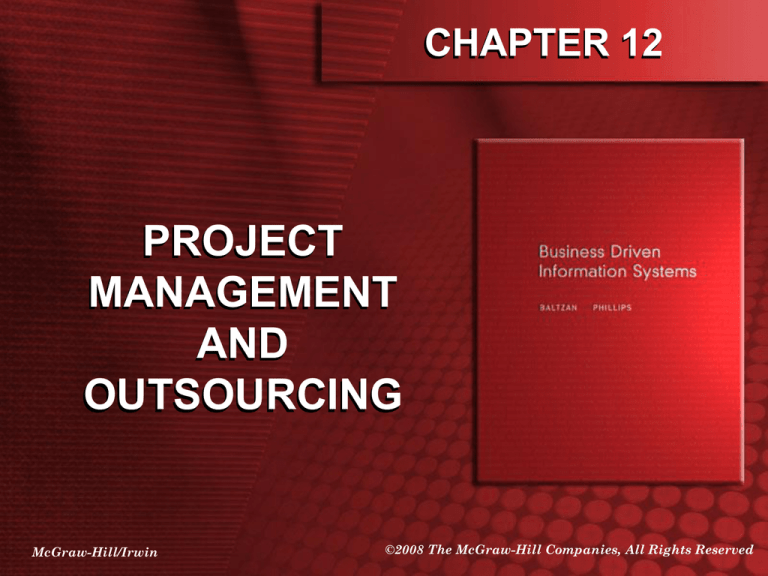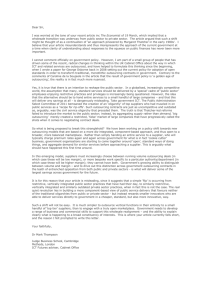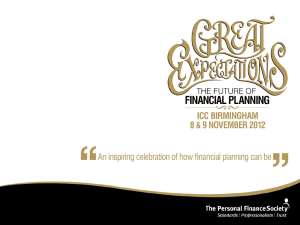
CHAPTER 12
PROJECT
MANAGEMENT
AND
OUTSOURCING
McGraw-Hill/Irwin
©2008 The McGraw-Hill Companies, All Rights Reserved
12-2
PROJECT MANAGEMENT
•
Project Advice
– It is fine to celebrate success but it is more
important to heed the lessons of failure.
– Good judgment is usually the result of
experience. And experience is frequently the
result of bad judgment. But to learn from the
experience of others requires those who
have the experience to share the knowledge
with those who follow.
12-3
PROJECT MANAGEMENT
•
Project management – the application of
knowledge, skills, tools, and techniques to
project activities in order to meet or exceed
stakeholder needs and expectations from a
project
–
•
Project management offers a strategic framework for
coordinating the numerous activities associated with
organizational projects
Project management software – supports the
long-term and day-to-day management and
execution of the steps in a project
12-4
PROJECT MANAGEMENT
•
Project management interdependent variables
12-5
PROJECT MANAGEMENT
•
•
Cost, time and scope are interdependent
variables
You cannot change one without changing the
others
–
–
•
For example, decreasing a project’s timeframe means
either increasing the cost of the project or decreasing
the scope of the project to meet the new deadline
Increasing a project’s scope means either increasing
the project’s timeframe or increasing the project’s cost
– or both – to meet the increased scope changes
Project management is the science of making
intelligent trade-offs among time, cost, and scope
12-6
PROJECT MANAGEMENT
•
•
•
A recent survey concluded that the failure rate of
IT projects is much higher in organizations that
do not exercise disciplined project management
A successful project is typically on time, within
budget, meets the business’s requirements, and
fulfills the customer’s needs
The Hackett Group analyzed its client database
and discovered:
–
–
–
3 in 10 projects failed
21 percent of companies state that they cannot adjust
rapidly to market changes
1 in 4 validate a business case for an IT project after
its completion
12-7
PROJECT MANAGEMENT
•
Common reasons why IT projects fall
behind schedule or fail
12-8
PROJECT MANAGEMENT
•
Expected growth for project management software
12-9
PROJECT MANAGEMENT
FUNDAMENTALS
•
Project – a temporary endeavor
undertaken to create a unique product or
service
•
Project management – the application
of knowledge, skills, tools, and
techniques to project activities in order to
meet or exceed stakeholder needs and
expectations
12-10
PROJECT MANAGEMENT
FUNDAMENTALS
•
Project deliverable – any measurable, tangible,
verifiable outcome, result, or item that is
produced to complete a project or part of a
project
•
Project milestone – represents key dates when
a certain group of activities must be performed
•
Project manager – an individual who is an
expert in project planning and management,
defines and develops the project plan, and
tracks the plan to ensure all key project
milestones are completed on time
12-11
PROJECT MANAGEMENT
FUNDAMENTALS
•
Project managers must take all of the activities below and ensure
they flow smoothly to develop and deliver a successful project
12-12
Choosing Strategic Projects
•
Organizations must determine which
projects to pursue
•
Three common techniques for selecting
projects
1. Focus on organizational goals
2. Categorize projects
3. Perform a financial analysis
12-13
Choosing Strategic Projects
• Techniques for choosing strategic
projects
– Focus on organizational goals—Managers
are finding tremendous value in choosing
projects that align with the organization’s goals.
Projects that address organizational goals tend
to have a higher success rate since they are
important to the entire organization.
12-14
Choosing Strategic Projects
– Categorize projects—There are various
categories that an organization can group
projects into to determine a project’s priority.
•
One type of categorization includes problem,
opportunity, and directives.
1. Problems are undesirable situations that prevent an
organization from achieving its goals.
2. Opportunities are chances to improve the organization.
3. Directives are new requirements imposed by management,
government, or some other external influence.
•
It is often easier to obtain approval for projects that
address problems or directives because the
organization must respond to these categories to
avoid financial losses.
12-15
Choosing Strategic Projects
– Perform a financial analysis—A number
of different financial analysis techniques can be
performed to help determine a project’s priority.
•
•
A few of these include net present value, return on
investment, and payback analysis.
These financial analysis techniques help determine
the organization’s financial expectations for the
project
12-16
Setting The Project Scope
•
Project scope – defines the work that must be completed
to deliver a product with the specified features and
functions, and typically includes:
–
–
–
–
–
Project product – a description of the characteristics the product
or service has undertaken
Project objectives – quantifiable criteria that must be met for the
project to be considered a success
Project deliverables – any measurable, tangible, verifiable
outcome, result, or item that is produced to complete a project or
part of a project
Project exclusions – products, services, or processes that are
not specifically a part of the project
Define the scope to build a basic calculator
•
•
The calculator must have numbers between 0 and 9 and be able to
add, multiply, divide, and subtract
Notice that the scope is the 30,000 foot view – it doesn’t define the
style, color, layout, materials, etc.
12-17
Setting The Project Scope
•
SMART criteria are useful reminders on
how to ensure that the project has created
understandable and measurable
objectives
12-18
Setting The Project Scope
•
What happens when objectives are not SMART
–
–
–
–
–
–
If an objective is not specific then it is open to interpretation
If an objective is not measurable then there is no way to determine
if the project is on track
If an objective is not agreed upon then chances are high the
project will fail
If an objective is not realistic then chances are high that the project
will fail
If an objective does not include a time frame then there is no way
to determine if the project is on track
Why is the following not SMART?
•
I will work hard this semester to achieve my goals?
–
–
–
–
Does not state what the goals are
Does not state how to measure working hard
Might not be realistic depending on the goals
Does have a time frame of a semester
12-19
Setting The Project Scope
•
Why is the following not SMART?
– I will work hard this semester to achieve my
goals?
•
•
•
•
Does not state what the goals are
Does not state how to measure working hard
Might not be realistic depending on the goals
Does have a time frame of a semester
12-20
Managing Resources and
Maintaining the Project Plan
•
Project plan – a formal, approved document that
manages and controls project execution
–
•
A project plan should be prepared by the team, rather
than by the individual project manager. WHY?
A well-defined project plan should be:
–
–
–
–
Easy to understand and read
Communicated to all key participants
Appropriate to the project’s size, complexity, and
criticality
Prepared by the team, rather than by the individual
project manager
12-21
Managing Resources and
Maintaining the Project Plan
•
Two primary diagrams used in project
planning include PERT and Gantt charts
– PERT (Program Evaluation and Review
Technique) chart – is a graphical network
model that depicts a project’s tasks and the
relationships between those tasks
(Dependencies and Critical paths are
found in PERT charts)
– Gantt chart – a simple bar chart that
depicts project tasks against a calendar
12-22
Managing Resources and
Maintaining the Project Plan
•
•
•
Dependency – a logical relationship between
the project tasks, or between a project task
and a milestone
Critical path – a path from the start to the
finish that passes through all the tasks that are
critical to completing the project in the shortest
amount of time
Why do you need to create dependencies?
–
Dependencies inform the project manager of tasks
associated with or affected by another task
12-23
Managing Resources and
Maintaining the Project Plan
•
PERT Chart EXPERT – PERT Chart Example
12-24
Managing Resources and
Maintaining the Project Plan
•
MS Project – Gantt Chart Example
12-25
CHANGE MANAGEMENT
FUNDAMENTALS
• Good project managers understand
the fundamentals of project
management and how to effectively
deal with change management and
risk management
• The Only Constant Is Change Heraclitus
12-26
CHANGE MANAGEMENT
FUNDAMENTALS
•
Change management – a set of techniques
that aid in evolution, composition, and policy
management of the design and implementation
of a system
–
–
Change management system – a collection of
procedures to document a change request and
define the steps necessary to consider the change
based on the expected impact of the change
Change control board (CCB) – responsible for
approving or rejecting all change requests
12-27
CHANGE MANAGEMENT
FUNDAMENTALS
12-28
CHANGE MANAGEMENT
FUNDAMENTALS
•
Additional reasons why change occurs
–
–
–
–
–
–
A resources quits or becomes ill
Company changes strategic direction
Leadership changes
Technology changes
Environment changes
Regulations or laws change
12-29
Preparing for Change
•
What can you do to anticipate and deal with change?
–
–
–
•
Change control board
Monitor change
Project plan
Three Important Guidelines for Effectively Dealing
with Change Management
1.
2.
3.
Institute change management polices - Create clearly defined
policies and procedures that must be followed each time a
request for change is received
Anticipate change - View change as an opportunity and embrace
it
Seek change - Every 6 to 12 months look for changes that may
be windows of opportunity. Review successes and failures to
determine if there are any opportunities for innovation
12-30
RISK MANAGEMENT
FUNDAMENTALS
•
Project risk – an uncertain event or
condition that, if it occurs, has a positive
or negative effect on a project objective
– Risk management – the process of
proactive and ongoing identification,
analysis, and response to risk factors
•
What type of risks effect you? How can
you deal with those risks?
12-31
RISK MANAGEMENT
FUNDAMENTALS
12-32
RISK MANAGEMENT
FUNDAMENTALS
12-33
Mitigating Risk
•
Actions to improve risk management capabilities
–
–
–
–
Promote project leadership skills—Hire individuals with strong
project management and project leadership skills as well as
business management skills. These individuals can be extremely
helpful in advisory and steering committee roles as well as
coaching roles.
Learn from previous experience—Over many years of collective
experiences, organizations have encountered hundreds of large
IT projects. Document and revisit development methodologies,
software tools, and software development best practices in order
to share this vital information across the organization.
Share knowledge—Working in team or group environments
tends to yield the most successful projects since individuals can
share their unique learning experiences.
Create a project management culture—Orient people from day
one on the importance of project management, change
management, and risk management. Be sure to measure and
reward project management skills and promote individuals based
on successful projects.
12-34
Successful Project Management
Strategies
•
Define project success criteria.
–
–
•
At the beginning of the project, make sure the stakeholders share a
common understanding of how they will determine whether the
project is successful.
Too often, meeting a predetermined schedule is the only apparent
success factor, but there are certainly others. Some examples are:
• increasing market share, reaching a specified sales volume or
revenue, achieving specific customer satisfaction measures,
retiring a high maintenance legacy system, and achieving a
particular transaction processing volume and correctness.
Develop a solid project plan.
–
–
The hard part of developing a plan is the thinking, negotiating,
balancing, and communication project managers will have to do to
develop a solid and realistic plan.
The time they spend analyzing what it will take to solve the
business problem will reduce the number of changes later in the
project.
12-35
Successful Project Management
Strategies
•
•
•
Divide and conquer. Break all large tasks into
multiple small tasks to provide more accurate
estimates, reveal hidden work activities, and allow for
more accurate, fine-grained status tracking.
Plan for change. Things never go precisely as
planned on a project; therefore, the budget and
schedule should include some contingency buffers at
the end of major phases to accommodate change.
Manage project risk. Failure to identify and control
risks will allow the risks to control the project. Be sure
to spend significant time during project planning to
brainstorm possible risk factors, evaluate their
potential threat, and determine the best way to
mitigate or prevent them.
12-36
OUTSOURCING
• Outsourcing – an arrangement by which one
organization provides a service or services for
another organization that chooses not to
perform them in-house
• This section focuses on businesses’ need to
undertake every effort to re-think and re-adopt
new processes
12-37
OUTSOURCING
Story 1: "The Customer is Never Right"
– We supplied the contract house with everything they needed to
get the job done. The first thing they did was tell us how our
tools and equipment were out-dated, and besides we were
using them incorrectly. (Due to legacy issues and budget
restrictions, constant hardware and software upgrades are not a
way of life here.) The next thing they did was re-format all of the
code on the project, including code outside the scope of their
portion, to meet their own formatting preferences. Any request
for information was like pulling teeth. They made me and
everyone on my team feel like we were imposing anytime we
asked them about the project (usually technical questions.)
– The most appalling thing is that towards the end of the project,
they debated us on how a portion of our system worked!!! It
was very insulting to have them infer that they understood our
system better than we did. They have been blacklisted from our
entire corporation.
12-38
OUTSOURCING
Story 2: "The Underbid"
– The contract house gave us a very competitive fixed-bid on a project.
This raised some concerns, but not enough to rule them out - money
talks, and we were trying to spend as little as possible. In retrospect,
going with them was a big mistake, but hindsight is always 20-20, right?
As they got further into the project, the scope of the project "grew". Why?
Because they did not give the project's complexity any credit when they
bid. We were not adding features or functionality - they were just
beginning to realize the scope of the work.
– It was clear their sales force had over-committed their engineering staff
in a terrible way. Their engineers resented us and their own
management, and it showed in their dealings with us. Not even halfway
through the project, they admitted they had underbid - now they needed
more money to complete the project. (Ironic, since one of the primary
factors in choosing them was the attractive pricetag.) The project was
completed by our own staff in-house once we decided we'd cut our
losses and sever our relationship.
– I don't know if we would outsource again. I feel like we bought software
development services from a used-car salesman.
12-39
OUTSOURCING
• Insourcing (in-house-development) – a
common approach using the professional
expertise within an organization to develop
and maintain the organization's information
technology systems
– Insourcing has been instrumental in creating a
viable supply of IT professionals and in fact in
creating a better quality workforce combining
both technical and business skills
12-40
OUTSOURCING
12-41
OUTSOURCING
• Reasons companies outsource
12-42
OUTSOURCING
• Factors driving outsourcing growth
include:
– Core competencies
– Financial savings
– Rapid growth
– Industry changes
– The Internet
– Globalization
12-43
THE OUTSOURCING
PHENOMENON
• According to research firm IDC, the worldwide IT
outsourcing market will reach $230 billion by
2009
• According to PricewaterhouseCoopers
“Businesses that outsource are growing faster,
larger, and more profitable than those that do not”
– Best Buy is the number one U.S. specialty retailer for
consumer electronics, personal computers,
entertainment software, and appliances
– Best Buy outsourced its enterprise systems to
Accenture
– The results of this outsourcing arrangement included a
20 percent increase in revenue which translated into a
$25 million profit
12-44
THE OUTSOURCING
PHENOMENON
• Most organizations outsource their noncore
business functions, such as payroll and IT
12-45
THE OUTSOURCING
PHENOMENON
• Outsourcing growth drivers
– Globalization – As markets open worldwide,
competition increases
– The Internet – Barriers to entry are reduced by the
Internet, such as a bookstore without an actual store
(Amazon.com)
– Growing economy and low unemployment rate –
Building a competitive workforce is harder and more
expensive
– Technology – Technology is advancing at such an
accelerated rate that companies often lack the
resources, workforce, or expertise to keep up
– Deregulation – As private industries deregulate
(telecommunications, energy) markets open and
competition increases
12-46
Outsourcing Benefits
• Outsourcing benefits include:
– Increased quality and efficiency
– Reduced operating expenses
– Outsourcing non-core processes allows focus on core
competencies
– Reduced exposure to risk
– Service providers economies of scale, expertise, and best
practices
– Access to advanced technologies
– Increased flexibility
– Avoid costly outlay of capital funds
– Reduced headcount and associated overhead expense
– Reduced frustrations and expense related to
hiring/retaining employees
– Reduced time to market for products or services
12-47
OUTSOURCING OPTIONS
• Onshore outsourcing –
engaging another company
within the same country for
services
• Nearshore outsourcing –
contracting an outsourcing
arrangement with a company
in a nearby country
• Offshore outsourcing –
using organizations from
developing countries to write
code and develop systems
12-48
OUTSOURCING OPTIONS
• Big selling point for offshore outsourcing
“inexpensive good work”
12-49
OFFSHORE OUTSOURCING
• Three categories of outsourcing countries: leaders, up-andcomers, rookies
12-50
The Leaders
•
•
•
•
•
Canada
India
Ireland
Israel
Philippines
12-51
The Leaders
• Canada
12-52
The Leaders
• India
12-53
The Leaders
• Ireland
12-54
The Leaders
• Israel
12-55
The Leaders
• Philippines
12-56
The Up-and-Comers
•
•
•
•
•
•
Brazil
China
Malaysia
Mexico
Russia
South Africa
12-57
The Up-and-Comers
• Brazil
12-58
The Up-and-Comers
• China
12-59
The Up-and-Comers
• Malaysia
12-60
The Up-and-Comers
• Mexico
12-61
The Up-and-Comers
• Russia
12-62
The Up-and-Comers
• South Africa
12-63
The Rookies
•
•
•
•
•
•
Argentina
Chile
Costa Rica
New Zealand
Thailand
Ukraine
12-64
The Rookies
• Argentina
12-65
The Rookies
• Chile
12-66
The Rookies
• Costa Rica
12-67
The Rookies
• New Zealand
12-68
The Rookies
• Thailand
12-69
The Rookies
• Ukraine
12-70
THE CHALLENGES OF
OUTSOURCING
•
Outsourcing challenges include
–
Contract length
1. Difficulties in getting out of a contract
2. Problems in foreseeing future needs
3. Problems in reforming an internal IT department after the
contract is finished
–
–
–
Competitive edge – Effective and innovative use
of IT can be lost when using an outsourcing service
provider
Confidentiality – Confidential information might be
breached by an outsourcing service provider,
especially one that provides services to competitors
Scope definition – Scope creep is a common
problem with outsourcing agreements
12-71
FUTURE OUTSOURCING TRENDS
•
Outsourcing is becoming less of a cost-saving
strategy and more an overall context for business
•
Outsourcing is approaching commodity status
•
Companies should look for value-based pricing
rather than the lowest possible price
•
Multisourcing – a combination of professional
services, mission-critical support, remote
management, and hosting services that are
offered to customers
12-72
OPENING CASE QUESTIONS
Change at Toyota
9. How could Toyota benefit from outsourcing?
10. If you had to choose a country to recommend
for outsourcing, which country would it be and
why?
11. Explain the issues facing Toyota from its
internal IT department if it decided to
outsource the project management of the
development of a new system
12-73
OPENING CASE QUESTIONS
Change at Toyota
12. What types of ethical issues might
Toyota encounter when considering
outsourcing?
13. What types of security issues might
Toyota encounter when considering
outsourcing?
12-74
CLOSING CASE ONE
Toronto Transit
1. Describe Gantt charts and explain how TTC
could use one to communicate project status
2. Describe PERT charts and explain how TTC
could use one to communicate project status
3. How could TTC use its Master Schedule to gain
efficiencies in its supply chain?
4. How could TTC use its Master Schedule to
identify change management and risk
management issues?
12-75
CLOSING CASE TWO
Circuit City
1. Explain why anticipating change would have
helped Circuit City remain as an industry
leader
2. Why are project management, change
management, and risk management critical to
a global company such as Circuit City?
3. Assess the impact on Circuit City’s business if
it failed to implement change management
strategies as it revamped its global
organization
12-76
CLOSING CASE TWO
Circuit City
4. What are some of the potential risks facing
Circuit City’s new business model?
5. Why would Opportunity, Resource, and Time
& Expense applications be of value to a
company like Circuit City?
6. Why would Circuit City benefit from
implementing good risk management and
change management techniques?







